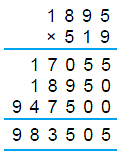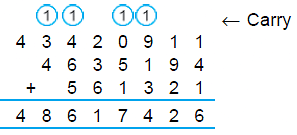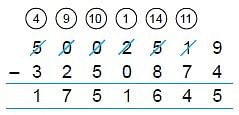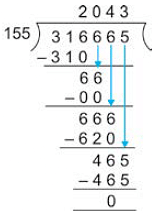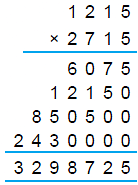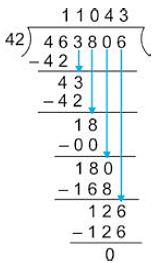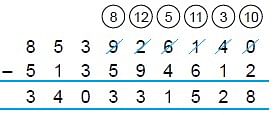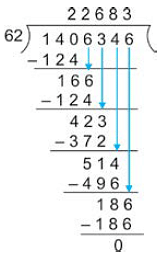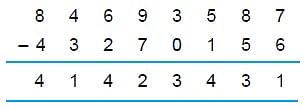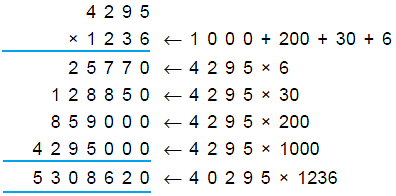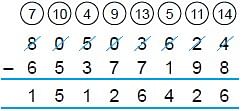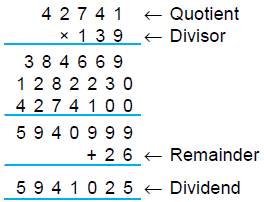Class 5 Maths Practice Question Answers - Operations on Large Numbers
Q1: In a factory, there are 519 workers. The salary of each worker is ₹ 1,895 per month. What is the total expenditure on the salary of the workers per month?
Salary of 1 worker = ₹ 1,895 per month
Number of workers = 519
Total expenditure on salary of workers per month = ₹1,895 × 519
Hence, the expenditure on the salary of the workers is ₹ 9,83,505 per month.
Q2: Estimate the product of 563 and 84.
563 → 600 (Rounding off to hundred’s place)
84 → 80 (Rounding off to ten’s place)
563 × 84 → 600 × 80 i.e., 48,000.
Estimated product is 48,000.
To find the estimated quotient, the dividend and the divisor are rounded off to their greatest place and their division gives the estimated quotient.
Q3: Add 4,34,20,911; 46,35,194 and 5,61,321.
Hence, 4,34,20,911 + 46,35,194 + 5,61,321 = 4,86,17,426
Q4: Find the difference between 5,41,72,384 and 60,00,32,107.
Thus, the difference between 5,41,72,384 and 60,00,32,107 is 54,58,59,723
Q5: In 2012, a factory produced 50,39,854 bulbs and in 2013, it produced 47,80,362 bulbs. Find the total number of bulbs produced by the factory in these two years.
Number of bulbs produced by the factory in 2012 = 50,39,854
Number of bulbs produced by the factory in 2013 = 47,80,362
Total number of bulbs produced = 50,39,854 + 47,80,362
Q6:
(a) Estimate the difference between 3,587 – 1,329
(i) to the nearest tens (ii) to the nearest hundreds
(b) Which of them is closer to the actual difference?
(a)
(i) Rounding off to nearest 10, we have
3,587 → 3,590 [7 > 5 ⇒ 7 → 10 and 87 → 90] and 1,329 → 1,330 [9 > 5 ⇒ 9 → 10 and 29 → 30]
Thus, 3,587 – 1,329 → 3,590 – 1,330 = 2,260(ii) Rounding off to nearest 100, we have
3,587→3,600 [8 > 5 ⇒ 87 → 100 or 587 → 600] and 1329 → 1,300 [2 < 5 ⇒ 29 → 00 or 329 → 300]
3,587 – 1,329 → 3,600 – 1,300 = 2,300
(b) Actual difference = 3,587 – 1,329 = 2,258.
The first approximation (to the nearest 10) 2,260 is closer to the actual difference
which is 2,258.
Q7: 50,02,519 students appeared for the Board Examination. Out of them, 32,50,874 were boys. How many girls appeared for the examination?
Total number of students appeared = 50,02,519
Number of boys = 32,50,874
Number of girls = 50,02,519 – 32,50,874
Hence, 17,51,645 girls appeared for the examination.
Q8: 155 matchboxes are packed in a carton. How many cartons will be needed to pack 3,16,665 matchboxes?
Number of matchboxes packed in 1 carton = 155
Total number of matchboxes to be packed = 3,16,665
Number of cartons needed = 3,16,665 ÷ 155Hence, 2,043 cartons are needed.
Q9: A packet contains 1,215 nails. How many nails are there in 2,715 packets?
Nails in 1 packet = 1,215
Number of packets = 2,715
Total number of nails = 1,215 × 2,715
Hence, the required number of nails are 32,98,725.
Q10: Divide 4,63,806 by 42.
Thus, 4,63,806 ÷ 42 = 11,043.
Q11: Estimate the sum 3,660 + 7,948 to the nearest tens and verify its closeness to the actual sum.
On estimating to nearest tens, we have :
3,660 → 3,660 [0 < 5 ⇒ 0 → 0]
7,948 → 7,950 [8 > 5 ⇒ 8 → 10 or 48 → 50]3,660 + 7,948 → 3,660 + 7,950 = 11,610.
Estimated sum = 11,610
Actual sum = 3,660 + 7,948 = 11,608
Q12: Multiply 13,578 by 329
Since, 329 = 300 + 20 + 9, we multiply 13,578 by 9, 20 and 300 respectively. Finally,
we add the results to get the required product.
Q13: Add 25,13,071 and 43,76,82
Hence, 25,13,071 + 43,76,825 = 68,89,896.
Q14: What must be added to 51,35,94,612 to get 85,39,26,140?
Sum of two numbers = 85,39,26,140
One number = 51,35,94,612
The other number = 85,39,26,140 – 51,35,94,612
Hence, the required number = 34,03,31,528.
Q15: In a city, there are 2,35,01,898 men, 1,56,70,314 women and 51,29,417 children. What is the total population of the city?
Number of men = 2,35,01,898
Number of women = 1,56,70,314
Number of children = 51,29,417
So, total population = 2,35,01,898 + 1,56,70,314 + 51,29,417
Hence, the total population of the city is 4,43,01,629.
Q16: The cost of 62 computers is ₹ 14,06,346. Find the cost of 1 computer.
Cost of 62 computers = ₹ 14,06,346.
Cost of 1 computer = ₹ 14,06,346 ÷ 62
Hence, the cost of 1 computer is ₹ 22,683.
Q17: Subtract 4,32,70,156 from 8,46,93,587.
Thus, 8,46,93,587 – 4,32,70,156 = 4,14,23,431.
Q18: Multiply 4,295 by 1,236
Q19: The population of a city is 8,05,03,624. There are 3,53,72,460 men and 3,00,04,738 women. The rest of them are children. Find the number of children in the city.
Number of men = 3,53,72,460
Number of women = 3,00,04,738
Total number of men and women in the city = 3,53,72,460 + 3,00,04,738.
= 6,53,77,198.Total population of the city = 8,05,03,624
Number of children in the city = 8,05,03,624 – 6,53,77,198
Hence, the number of children in the city is 1,51,26,426.
Question 20: Divide 59,41,025 by 139 and check the answer.
Hence, quotient = 42,741, remainder = 26.
check : Dividend = quotient × divisor + remainderHence, the division is correct.
|
58 videos|122 docs|40 tests
|
FAQs on Class 5 Maths Practice Question Answers - Operations on Large Numbers
| 1. What are operations on large numbers? |  |
| 2. How do we perform addition of large numbers? |  |
| 3. What is the process for subtracting large numbers? |  |
| 4. How can we multiply large numbers efficiently? |  |
| 5. What is the process for dividing large numbers? |  |

|
Explore Courses for Class 5 exam
|

|
